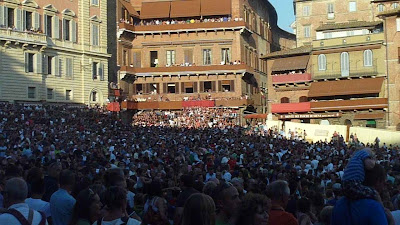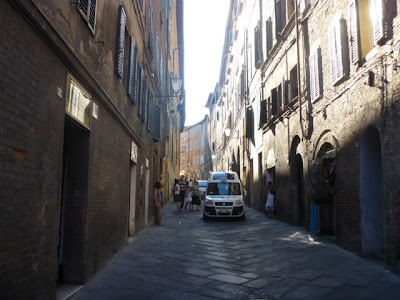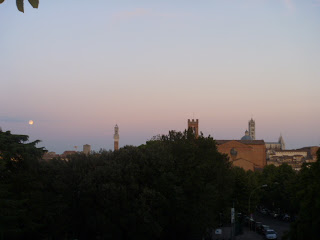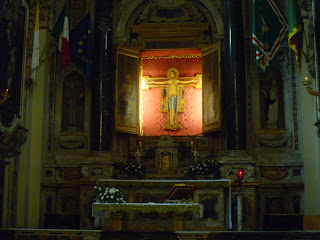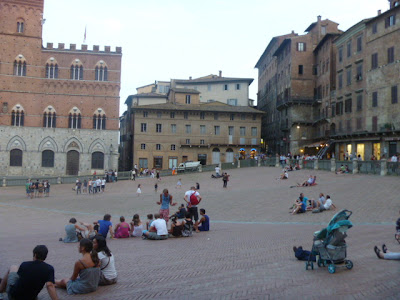After the noise and confusion of Siena last week’s revelry, on this one, I came out with an opposite yet exhilarating experience. Siena is also home of a so called Eucharistic miracle (giving in the fact that the Eucharist is a miracle in itself). The Basilica of Saint Francis custodies 140 hosts which were consecrated in a Mass on August 14, 1730. After 281 years, these hosts remain as fresh as they were made today. (See a summary of the complete story below).
The belief in the real presence of Christ in the Eucharist is very challenging for Catholics. It is difficult to admit the fact of transubstantiation, because bread and wine retain their appearances after the prayer of consecration. One day, back in Ituango, I had a discussion with a dear nun friend about the lack of preservation of consecrated hosts. She complained that there were no reasons to consume and rotate consecrated hosts kept for a long time in the tabernacle. Why? because they should not spoil since they contain the body of Christ. I said, well that’s a very good point, let me chew that one. And I chew and chew it and trying not to give into doubt I finally concluded: the appearance of bread remains and so the material aspect of it. Therefore it is subject to time as anything on earth is.
I don’t mean here to engage into a theological apology about the Eucharistic presence, but to reflect on our intake of it, as believers. I would like to quote again St Thomas Aquinas Eucharistic hymn Pange Lingua. The last verse of the Tantum ergo stanza, says: praestet fides supplementum sensuum defectui, which translates: “Let faith supplies when our human senses fail.” My great teacher and hero professor in the seminary, Fr. Bob Barron explains it asking: how many times our senses deceive us? The Eucharist is not the only situation when our senses deceive us.
When we stare on the dark sky in a clear night, we say there are the stars because we see them. In fact they are not there, what we see is an illusion of what was there before. Who tells us that? A higher authority in the field, a scientist. Or in the psychological level, when we see a person for the first time that made a bad impression on us we say, he is a jerk. But later a friend, who knows him well, will come up and tells us, no he is a very kind, generous person. An appearance just can prompt us to make a bad statement on someone before knowing him. But an authority on knowing the person, a friend, tells us the true about him.
Or Diego the explorer in Siena. I was walking by a busy narrow street and saw, outside a restaurant, a table with plates of pieces of ham and different cheeses. There were no chairs and many people were there standing around. It seemed to me like a sample’s stand. So I stopped, approached the table and took a piece of cheese. What seemed to be a degustation station (like in Costco) was in fact a real table for a big party of people on the restaurant. Who told me that? The everybody’s stare on me as I took the cheese and a waiter who saw me passing by; real authorities in the truth of the situation. (I apologized, of course; and embarrassed explained what I thought it to be. All laughed and they invited me to their party). In the Eucharist, there we see bread and wine when in fact there are the body and blood of Christ. Who tells us that? But the highest authority of all, Jesus Christ himself.
Why it is still the most difficult belief of our faith? I asked that question in prayer before the miraculous hosts in St Francis. Why the miracle of each consecration is not enough to change us? After a while of pondering, I came up with an answer close to last’s week post. It demands accountability. My proclamation and acknowledgement of the mystery of our faith make me a subject of it, what else should I be? It is the Lord! God humiliated to the state of grain and grapes. It embarrasses one who does not want to believe. And if one does, then the Eucharist as the true, real presence of Christ; as a miracle of love invites me to comfort my life to him. Before whom I am accountable to for the love I give.
 |
| Exterior of the Basilica of Saint Francis in Siena |
 |
| Main Altar of the Basilica |
 |
| Tabernacle Altar where the miracle hosts are kept |
 |
| Monstrance with the miracuolose hosts |
Story of the Eucharistic Miracle the Siena
(from Eucharistic Miracles by Joan Carroll Cruz):
On August 14, 1730 most of the Sienese population and clergy were attending the devotions of the vigil of the feast of the Assumption of the Blessed Virgin Mary in the Cathedral. Taking advantage of this, thieves entered the church of Saint Francis and carried away a golden ciborium containing consecrated hosts. Nothing was known until the next morning when the priest opened the tabernacle at the Communion of the Mass. The suspicion of a sacrilege was confirmed when later a parishioner found the lid of the ciborium lying in the street.
Two days later, on August 17, while praying in the Church of St. Mary of Provenzano, a priest's found 348 hosts in the offering box. The Hosts were compared with some unconsecrated ones used in the Church of St. Francis, and proved to be exactly the same size and to have the same mark of the irons upon which they were baked. The number of Hosts corresponded exactly to the number the Franciscan friars had estimated were in the ciborium.
Since the offering box was opened but once a year, the Hosts were covered with the dust and debris that had collected there. After being carefully cleaned by the priests, they were enclosed in a ciborium and placed inside the tabernacle of the main altar of the Church of St. Mary and later were taking back to the Church of St. Francis.
During the two centuries that followed it has sometimes been wondered why the Hosts were not consumed by a priest during Mass, which would have been the ordinary procedure in such a case. While there is no definite answer, there are two theories. One explanation is that crowds of people from both Sienna and neighboring cities gathered in the church to offer prayers of reparation before the sacred particles, forcing the priests to conserve them for a time. The other reason the priests did not consume them might well have been because of their soiled condition. While the Hosts were superficially cleaned after their discovery, they still retained a great deal of dirt. In such cases it is not necessary to consume consecrated Hosts, but it is permitted to allow them to deteriorate naturally.
The truth is that these hosts never have deteriorated. With the passage of time, the Conventual Franciscans became convinced that they were witnessing a continuing miracle of preservation. Many investigations and examinations have been made at intervals over the years. The final statement of sciences has been that the holy Particles of unleavened bread represent an example of perfect preservation ... a singular phenomenon that inverts the natural law of the conservation of organic material. It is a fact unique in the annals of science.
The miraculous Hosts have been cherished and venerated in the Basilica of St. Francis in Siena for over 250 years.


